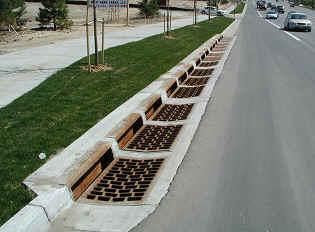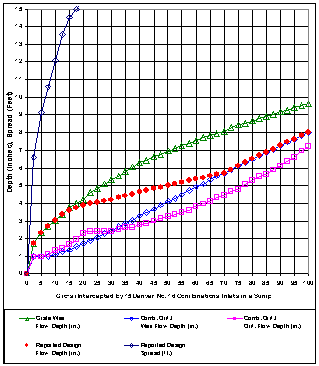
Inadequate or overkill? These Denver No. 16 combination inlets were sized using the HEC-22 method.
When the District updated the Urban Storm Drainage Criteria Manual (USDCM) in 2001, the chapter on streets, inlets, and storm sewers was modified to follow the criteria set forth in the Federal Highway Administration (FHWA) Hydraulic Engineering Circular 22 (HEC-22, 2nd edition). Since then, it has become apparent that there is a lack of physical test data on the interception capabilities for the types of storm sewer inlets that are currently being used in the Denver Metropolitan area.
 |
|
Inadequate or overkill? These Denver No. 16 combination inlets were sized using the HEC-22 method. |
The HEC-22 methodology is based on a 1977 FHWA physical modeling of several welded and riveted bar steel grates on grades. Since that time other agencies, including the Kansas and South Carolina DOTs and the Ontario Ministry of the Environment, have conducted physical model studies for inlets used by those agencies. None of these are similar to the types of inlets and grates favored by agencies in Colorado. In addition, none of these studies tested inlets in sump conditions to study the weir vs. orifice control transitions.
The Neenah Foundry has physically modeled many of their cast iron grates in a 4'-wide flume, where much of the flow was forced directly over the grate. That testing provides a basis for comparing one Neenah grate to another, but does not provide a method to correlate the interception rates of Neenah grates to the interception rates of the bar steel grates modeled by the FHWA in 1977.
So, when using either HEC-22 or the Urban Storm Drainage Criteria Manual to size inlets other than those specifically modeled, the designs only approximate the interception rate by comparing the proposed inlet type and grate used to one of the modeled bar steel grates. Also, when sizing curb opening inlets, both manuals refer the designer to standard weir and orifice equations, which do not fully account for the states of flow actually existing in the approaching gutter and in the inlet opening itself.
 |
|
This graph is produced by the UD-Inlet v2.02.xls workbook and represents our best approximation of the capacity for Denver No. 16 combination inlets in a sump condition. From our physical model we will adjust the equations as necessary to give more accurate results, which may result in construction cost savings. |
To provide a better basis for designing the inlets that are most commonly used in Colorado, the District is proposing to conduct a physical model study in 2005. Depending on the available funding, we hope to study the following inlet types:
These inlets will be modeled on a variety of longitudinal slopes as well as in sump condition. If funding permits, we will also analyze the clogging characteristics of each inlet type.
To achieve these goals in 2005, the District already has funding commitments from several county and city governments. We are hoping that other cities and counties will also commit funds to help us achieve our goals. Each funding agency will have a representative on the advisory committee for this study.
All it takes to join this team is to commit funds to this effort on the order of what it takes to construct a single or double Type R inlet. Contact Ken MacKenzie of our staff if you would like to help us fund this effort.